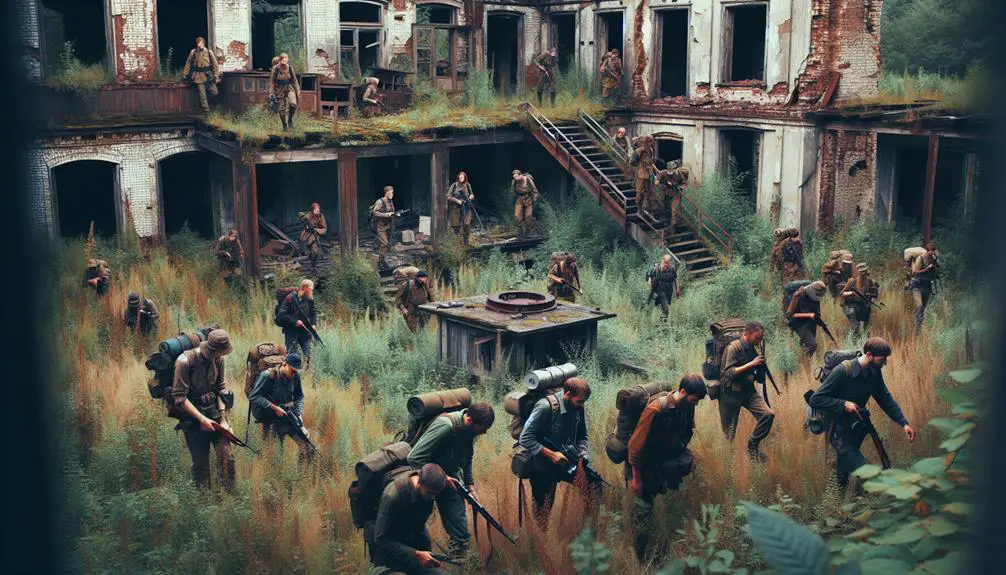During the Civil War era, towns faced economic hardships from job loss and disrupted industries. Battles also left scars, hindering rebuilding efforts. Transportation changes with the expansion of railroads caused some towns to decline. Urban sprawl attracted residents away, leaving smaller towns with fewer opportunities. Additionally, environmental challenges and natural disasters added to the struggles of these towns. This complex web of factors contributed to the abandonment of Civil War-era towns, painting a detailed picture of their demise. Further insights into these issues reveal a deeper understanding of the challenges faced by these communities.
Key Points
- Economic decline post-war led to job loss and lack of resources for rebuilding.
- Battle destruction left towns in ruins, hindering post-war rebuilding efforts.
- Changes in transportation routes made old routes obsolete, impacting trade and town viability.
- Shift in population to urban centers for better opportunities led to smaller town decline.
- Environmental factors and natural disasters worsened post-war challenges, leading to abandonment.
Economic Decline in Post-War Period
During the Reconstruction era following the Civil War, many towns in the South experienced a significant economic decline. The aftermath of the war led to widespread job loss as industries and plantations that relied on slave labor were disrupted. With the emancipation of slaves and the destruction caused by the war, many former slaves and poor whites struggled to find employment, exacerbating the economic woes of these towns.
Infrastructure decay further compounded the economic challenges faced by these communities. The destruction wrought by the war left many towns in disarray, with damaged roads, bridges, and buildings hindering economic activities. The lack of resources and investment to rebuild these essential structures meant that transportation and communication networks were severely hampered, making it difficult for businesses to operate efficiently.
As a result, the combination of job loss and infrastructure decay created a downward spiral for many towns in the South, leading to their eventual abandonment as residents sought better opportunities elsewhere. The economic decline during this period not only shaped the fate of these towns but also had lasting effects on the region's development.
Impact of Battle Destruction
The devastation wrought by battles during the Civil War left a lasting imprint on the physical and social fabric of numerous towns in the South. The impact of battle destruction was profound, leading to widespread destruction of infrastructure, homes, and businesses. Many towns faced challenges in the aftermath of the war, struggling to rebuild and recover from the immense damage caused by the conflict.
Reconstruction efforts played a vital role in attempting to restore these towns to their former glory. However, the sheer scale of destruction often overwhelmed these initiatives. Historical preservation became increasingly important as communities sought to commemorate the sacrifices made during the war and preserve the memories of those who fought and perished.
Despite the resilience of many towns and their inhabitants, the scars left by battle destruction were deep and long-lasting. The physical reminders of the war served as poignant symbols of the challenges faced by these communities in the post-war period. Through reconstruction efforts and historical preservation, these towns sought to honor their past while looking towards a more hopeful future.
Changes in Transportation Routes
Amidst the aftermath of the Civil War, significant alterations to transportation routes reshaped the connectivity and accessibility of towns across the war-torn region. The expansion of railroads played a pivotal role in transforming the way people and goods moved throughout the area. With the introduction of more extensive railroad networks, towns that weren't previously well-connected to major cities or markets suddenly found themselves with easier access to trade and economic opportunities. This shift led to the decline of towns that were heavily reliant on older, less efficient modes of transportation.
Furthermore, the decline of canal systems also played an important role in the abandonment of certain towns. Canals, once essential for transporting goods and people, became obsolete with the rise of railroads. Towns that were once bustling trading hubs along these canals saw their importance diminish as goods could now be transported faster and more efficiently by rail. The inability of these towns to adapt to the changing transportation landscape ultimately contributed to their abandonment as populations dwindled and economic activity moved elsewhere.
Shift in Population Centers
Following the changes in transportation routes, towns experiencing a shift in population centers saw residents and businesses gravitate towards new hubs of activity and opportunity. During the Civil War era, as urban sprawl began to take shape, larger cities started attracting more inhabitants due to increased job prospects and amenities. The population growth in these urban areas led to a decline in smaller towns as resources and focus shifted to the burgeoning city centers. People were drawn to urban areas where industrialization was on the rise, offering better-paying jobs and a chance for a more comfortable lifestyle.
As businesses relocated to urban centers, smaller towns struggled to compete, resulting in economic downturns and declining populations. The shift in population centers also meant that services and infrastructure in smaller towns weren't able to keep up with the growing demands of the populace. This disparity further accelerated the migration of people towards urban areas, leaving once-thriving towns deserted and abandoned.
Environmental Factors and Natural Disasters
Environmental changes and natural disasters played a significant role in the abandonment of Civil War-era towns. During this period, the lack of advanced climate change adaptation strategies and urban planning exacerbated the impact of these factors. Towns were often situated in areas vulnerable to flooding, hurricanes, and other natural disasters, making them unsustainable in the long run. The Civil War itself disrupted infrastructure and supply chains, leaving towns ill-prepared to handle environmental challenges.
In the aftermath of the Civil War, many towns struggled to rebuild and adapt to changing environmental conditions. The lack of proper urban planning meant that structures weren't resilient to natural disasters, further contributing to their decline. Climate change adaptation was virtually non-existent, leaving these towns at the mercy of increasingly unpredictable weather patterns.
As a result, the combination of environmental factors and natural disasters proved too much for many Civil War-era towns to overcome. Without the necessary measures in place to mitigate these challenges, abandonment became a common fate for these once-thriving communities.
Frequently Asked Questions
What Role Did Social Factors Play in the Decline of Civil War-Era Towns?
Seeking answers about the decline of Civil War-era towns? Social dynamics were pivotal. Economic pressures spurred urbanization, leading to labor migration. Remember, the fabric of history is woven with the threads of societal shifts.
How Did Advancements in Technology Contribute to the Abandonment of These Towns?
Advancements in technology, like railroad expansion and telegraph communication during the Industrial Revolution, contributed to the abandonment of Civil War-era towns. Urbanization led to a shift in population towards cities, leaving smaller towns deserted.
Were There Any Cultural or Religious Reasons That Led to the Abandonment of These Towns?
Cultural traditions and religious beliefs often played significant roles in the abandonment of Civil War-era towns. These values influenced decisions, migration patterns, and community cohesion, shaping the fate of these once-thriving settlements.
How Did the Political Landscape of the Post-War Period Impact the Abandonment of These Towns?
Amid political turmoil and economic struggles post-war, the landscape shifted, impacting town abandonment. The power struggles and financial strains left communities fractured, leading to deserted streets and empty homes as remnants of a fractured past.
Were There Any Specific Events or Incidents That Accelerated the Decline of These Towns?
Specific events like economic downturns and natural disasters hastened the decline of these towns. Factors such as failed industries and devastating floods exacerbated existing challenges, leading to increased abandonment as residents sought better opportunities elsewhere.



